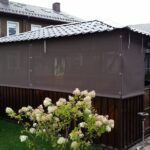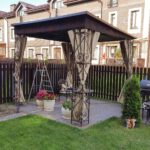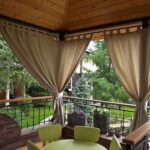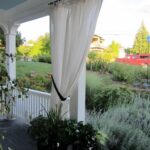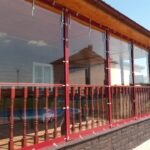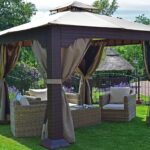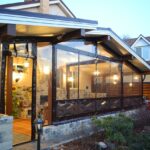Description of outdoor curtains for the veranda, gazebo and terrace
Curtains and curtains in gazebos or on open verandas are not just decoration, but also protection from sunlight, dust, prying eyes, rain and insects.
Fabrics for curtains are suitable reinforced (reinforced), with special strength and properties to resist sunlight and moisture.
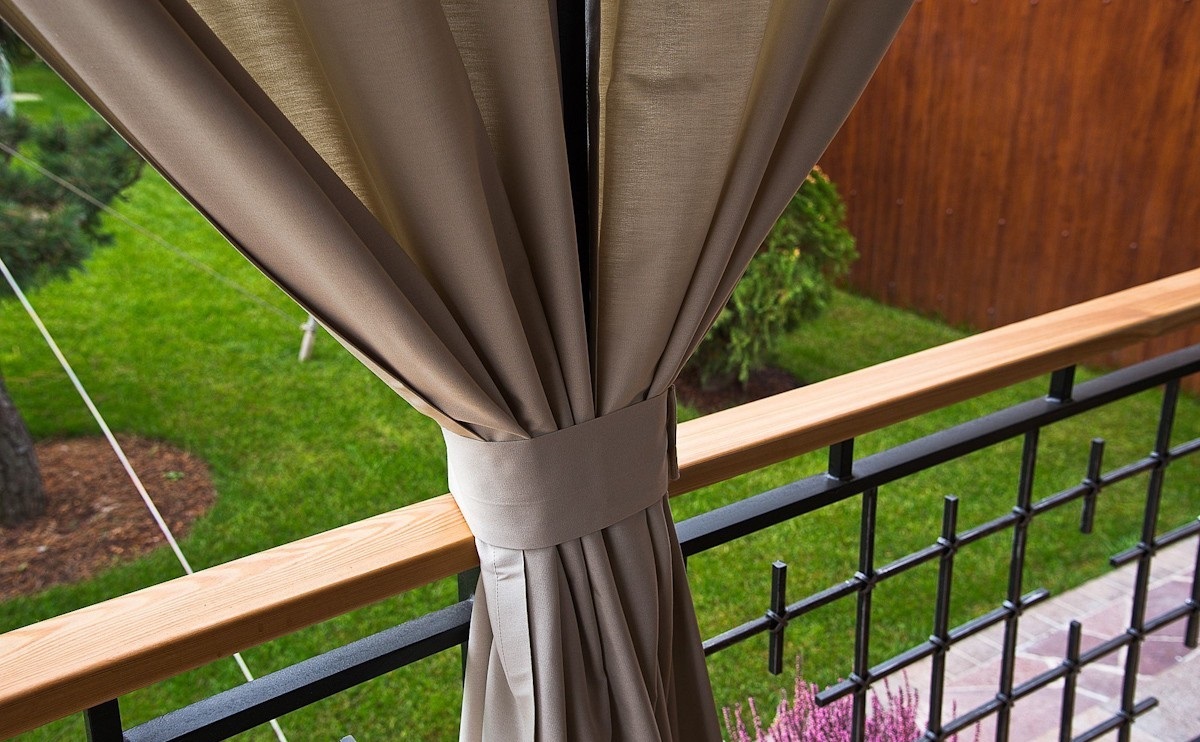
- Characteristics of street curtains
- What functions do
- Advantages and disadvantages
- Types of curtains
- How to choose the right one
- How to make street curtains with your own hands
- How to hang curtains
- Care rules
- Video: a variety of curtains for the gazebo and veranda
- Varieties of street curtains for gazebos and terraces in the photo
Characteristics of street curtains
The so-called outdoor curtains date back to ancient Rome. These types of curtains are ubiquitous these days, but fabrics, unlike natural ancient Roman materials, are much more durable for outdoor use.
There are a lot of types of outdoor curtains, and their choice depends on the purpose of use and functionality, the design of the veranda or gazebo, the length of the openings that need to be curtained.
There are also exclusively decorative curtains, they are placed near the columns or pillars of the building and are almost never straightened. They can be made from lighter fabrics than functional counterparts.

What functions do
Outdoor curtains for open buildings perform important and necessary functions:
- Protect from wind and rain, keep warm.
- They close the inside of the building from prying eyes.
- In the case of "soft glass" - keep warm on the veranda or terrace, but do not impede sunlight.
- Mesh curtains keep mosquitoes and flies out.
- They decorate the structure, and in some cases are a good disguise for not very attractive windows or racks.

Advantages and disadvantages
Almost all the advantages of outdoor curtains are listed in functions - protection from almost everything that may cause inconvenience to those present on the terrace or in the gazebo.
Additional benefits:
- Protection of the "winter garden" or seedlings in the cool season, while letting in sunlight inside the building (when using transparent covers with "soft glass").
- Protection of floors, walls, furniture of buildings from rain drops and sunlight, preventing burnout and destruction.
- Covers made of dense, opaque, water-repellent fabric are an excellent solution for covering the walls of outdoor showers and outdoor cabinets.
- Since the use of curtains on verandas and gazebos is seasonal, they are made easily removable.

There are also disadvantages, some of them are associated with the wrong choice of materials, errors in operation or installation of structures:
- In strong winds, some curtains may tear or fly violently to the sides.
- Fabric options for curtains must be periodically removed for washing, then reinstalled.
- Due to frequent washes (especially with incorrectly selected products), impregnated fabrics may lose their dust and moisture protection properties.
- Curtains can fade in the sun. Plastic curtain types can crack in winter.
- For heavy fabrics, special reinforced cornices and fasteners are needed.
- Buying curtains for the entire terrace or gazebo will cost a decent amount. As a rule, standard options in stores are not suitable, and there is a need for an individual order for manufacturing or self-tailoring.

Types of curtains
Many varieties of outdoor curtains allow you to solve practical problems in each specific case, choose your own version:
- Classic fabric curtains. They can be both airy veils and dense canvases that can be easily opened. They are collected on hooks near the racks or on the sides of the openings.
- Fabric curtain covers for garden showers and wardrobes.
- Sliding options: panjury, fabric or bamboo roller blinds, blinds, roller shutters, Roman reinforced blinds.
- Flexible plastic PVC shields. They perform the function of glass, protect well from cold and wind, but do not interfere with light. They can exactly repeat the perimeter of the gazebo, have openings for "windows" and "doors" with special zippers.

Roller blinds
Rolled protective panels for verandas and gazebos can be fabric, straw, reed, acrylic.
They are very convenient, they allow you to close the building only from those sides from which it is necessary. When folding, they are completely removed under the roof in the form of rolls, which gave them their name.
Raf curtains
Blinds, most often, are made of wood, but they can also be made of plastic "wood-like".
They are in the form of horizontal slats located at an angle or ends to each other, like blinds. They allow you to regulate the penetration of light and air into the building.

The design of the blind is heavy, stationary, it is not affected by the wind and will protect well from rain. It does not need to be removed from the wall for washing and cleaning.
Classic curtains
Classic curtains, when used on open terraces or gazebos, have their drawbacks, but at the same time they are popular, as they greatly decorate the building and are convenient to remove and wash if necessary.
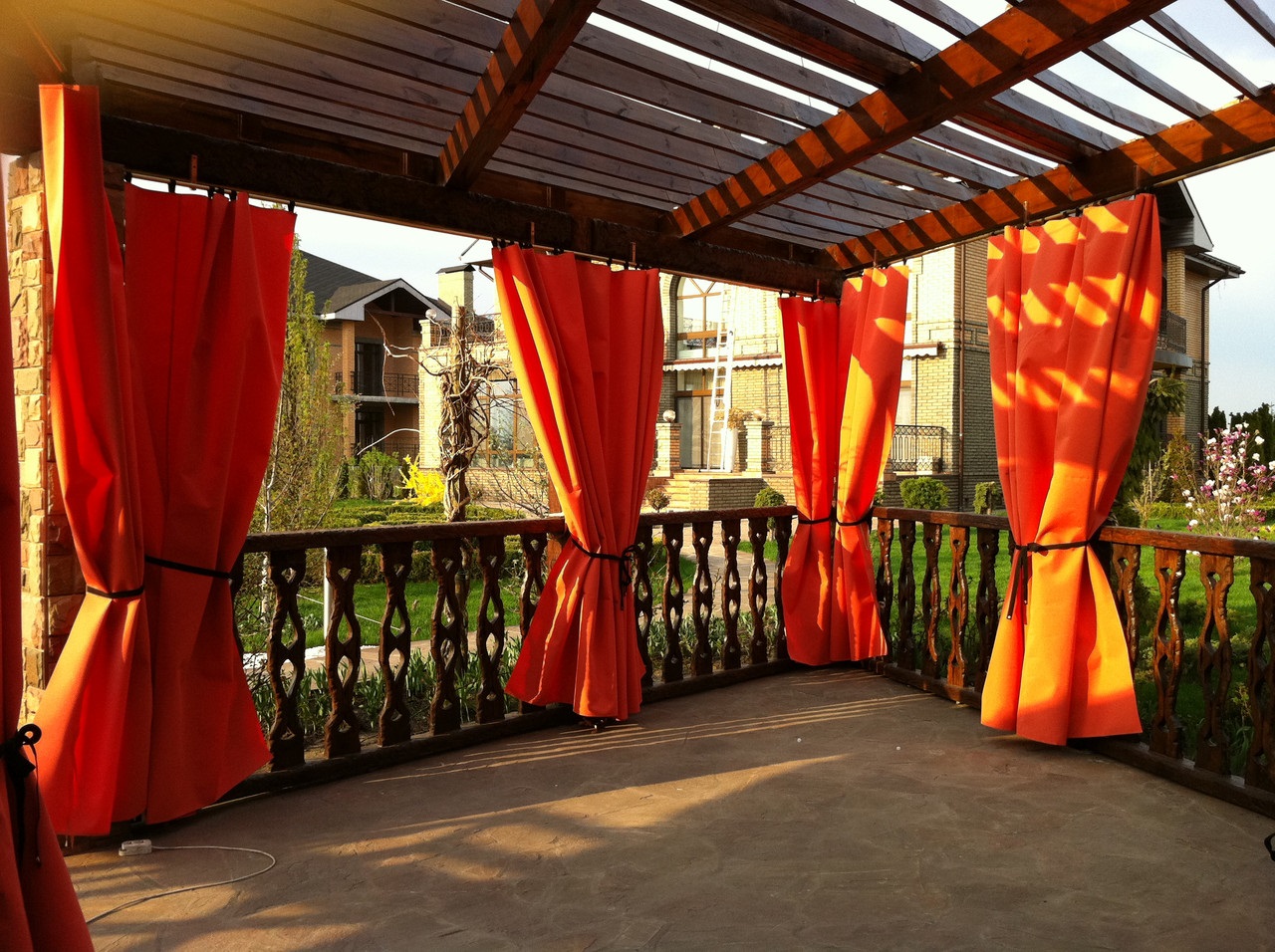
These can be purely decorative options, fixed on the sides of openings or at the racks of a building, or functional, easily twitching.
Plastic (PVC)
PVC flexible transparent curtains are used where enhanced protection of the interior space is required.
In particular, they are widely used for equipping greenhouses and verandas, cafes and terraces, where even in the cold season, heat is retained under the influence of the sun or an internal heat source.

In houses, such curtains are made where you need to organize a winter garden, display indoor flowers or seedlings, and not be afraid of the influence of the cold.
The main disadvantage is solid screens and tightly fastened openings in them do not allow fresh air to penetrate inside, it is necessary to periodically open and ventilate the room.
But transparent and soft pvc curtains for gazebos and verandas allow sunbathing when the outside temperature is far from summer.
Tarpaulin
Tarpaulin curtains serve as a good protection for the room. In addition, they are plastic, and can become a decoration of the structure, if you choose the right color and beautifully fix them on the grabs.
Unlike classic curtains, the tarpaulin can withstand even strong winds and rainstorms.
Tarpaulin is a heavy material, therefore reinforced fasteners and curtain rods are needed to install such curtains. Often a tarpaulin curtain is installed on steel eyelets, and the cornice is chosen in the form of a steel pipe.

Acrylic
Acrylic fabrics have undeniable advantages over other varieties - they are lighter than tarpaulin, plastic and beautiful, can be absolutely any color or color, as well as two-layer or three-layer (blackout).

Unlike the classics, these curtains will protect well from rain and sunlight, while they will not need to be washed often - they are self-cleaning.
Canvas
Canvas curtains look stylish and fresh, especially with wood furnishings and country house rattan furnishings. But they are less practical than acrylic and tarpaulins, they will protect only from the bright sun, but not from dust and rain.

More often they perform only a decorative function.
Tissue
When choosing a fabric option, you need to prepare for the fact that the curtains will fade in the sun and collapse under the influence of atmospheric influences.
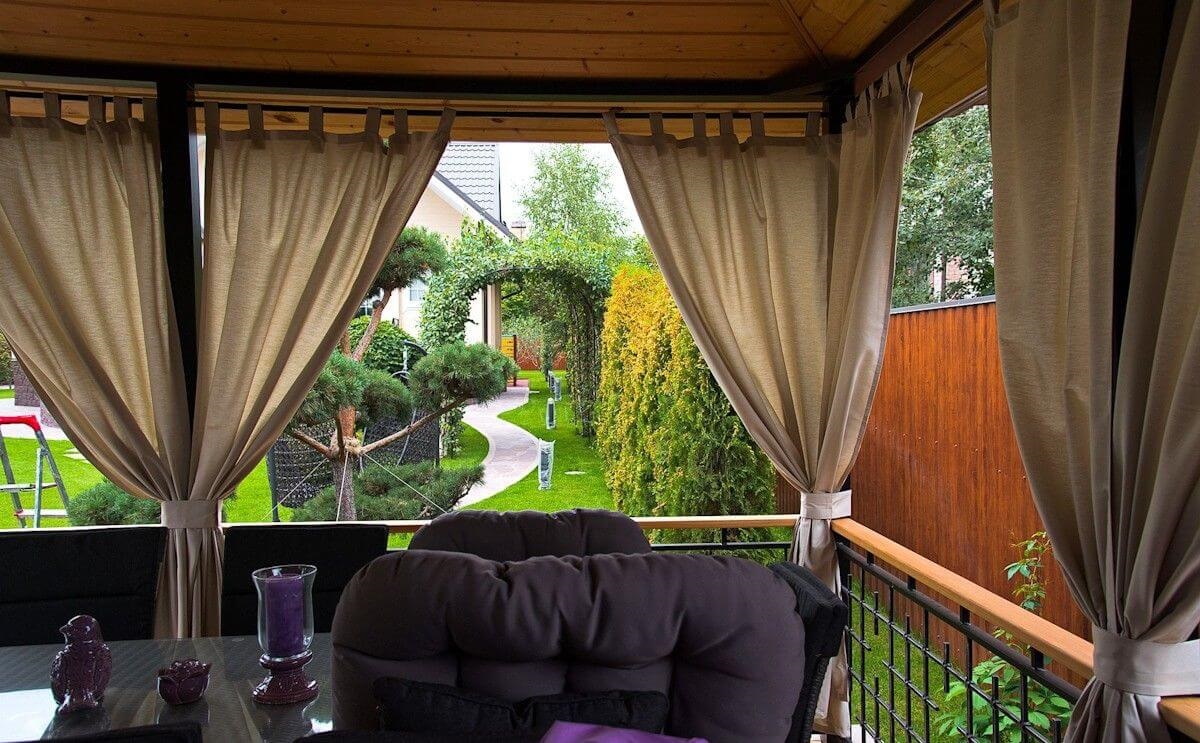
They are used where there is little direct sunlight and there is no need for enhanced protection of the internal space.
Transparent
Transparent and translucent curtains provide little protection, if we are not talking about PVC screens, or polyethylene curtains, which we have already mentioned.
Transparent options can also be a mosquito net that keeps insects out, a decorative woven net for dissecting direct light, a transparent organza.
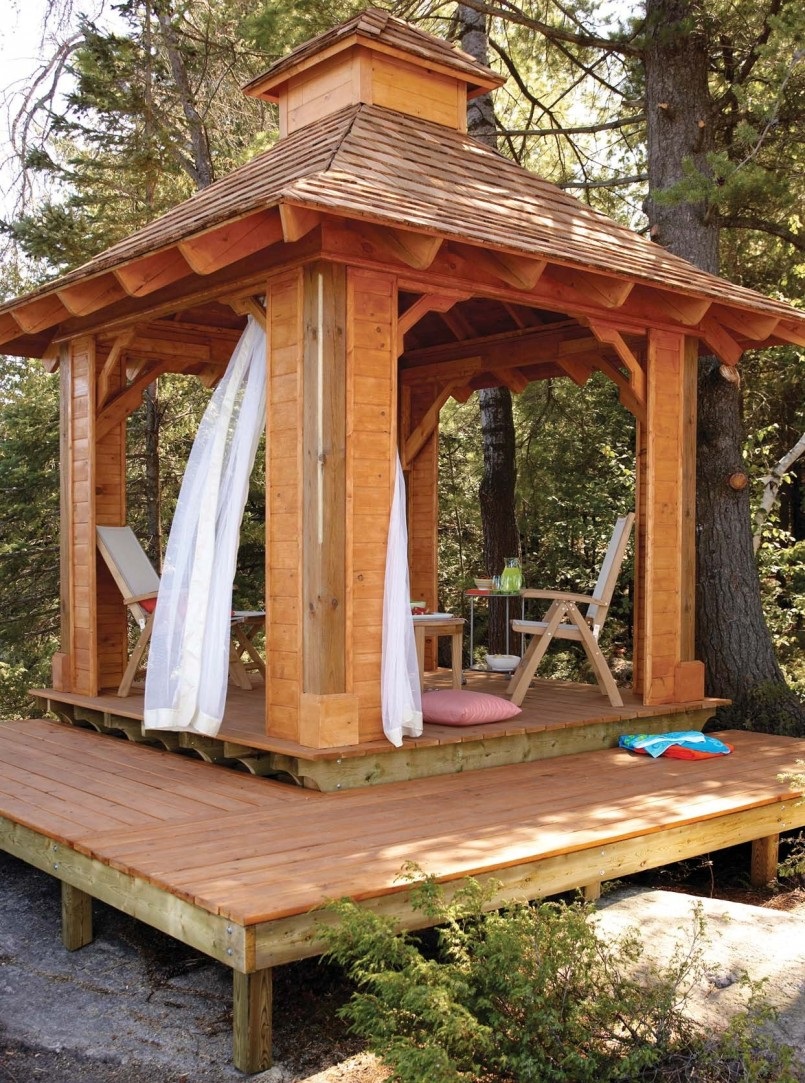
How to choose the right one
It is better to choose outdoor curtains for outdoor terraces and gazebos from the photos that can be found on design sites. Before choosing the shape, model and fabric of curtains, you need to decide on the functions that they should perform.
When buying ready-made options for curtains or ordering from a studio, you need to remove all dimensions - the height of the ceiling of the building, the total length of the open surface of the walls (each wall separately), the height and width of each opening from the rack to the rack.

How to make street curtains with your own hands
For self-production of curtains for a gazebo, pergola or terrace, any fabric that the owner likes is suitable. But for beginners, for the first experience, it is better to take natural fabrics that crumble less at the edges and do not slip like organza or veil.
For sewing, you need to prepare the fabric itself, purchased according to previously taken measurements, matching threads, a sewing machine, scissors and a little patience.

The work should take place in stages:
- Lay out the fabric, mark the curtains by size, add allowances for the hem and seam from the sides and top - 2.5-3 cm, 10 cm from the bottom.If the curtains are supposed to be planted on the eyelets (an even number), then the hem must be for the width of the eyelet + 2 cm.
- Sweep the curtains, iron the folds if necessary.
- Sew the sides first, then the bottom and top of the curtain.
- Put the eyelets on the curtain where they will be (at regular intervals), circle the inner circles, cut them out. First put the ring on the wrong side opposite the hole, then snap it with the front ring.
- In order to fix the curtain on the sides on the roof racks, it is necessary to sew and attach bandages to it on both sides (preferably 2-3 in height). Instead of bandages, you can also make hooks (tape 5-7 cm wide and 40-50 cm long), which are fixed on the rack between the openings. It is better to sew adhesive tape or buttons for fastening to the edges of the hooks.

How to hang curtains
The increased impact of climatic changes, wind on the curtains requires proper fastening of the curtain structure, in order to avoid its breakage.
- Outside curtain rods must be very strong and, in the case of tarpaulin curtains, reinforced to withstand this load.
- Ceiling runners, preferably made of aluminum, are also suitable for fixing the usual classic versions of curtains, light veils and curtains.
- It is enough to fix curtains on eyelets on eaves with a round or square cross-section.
- Ready-made protective external curtains are always included in the kit.

Before making a choice, you need to get acquainted with all the options for fastening outdoor curtains. The stores have pivoting and automatically closing mechanisms, retractable fasteners with brackets, different types of cornice configurations - in any case, before buying, you need to consult with the seller about the most optimal fastening and cornice for the selected option.
On the veranda
Veranda is the most open structure with a roof, and openings, most often, to the floor. To decorate the verandas, long curtains made of fabric, tarpaulin or acrylic are needed, which can completely block all openings or gather at the racks for hooks.

It is better to fix the curtains on tubular cornices under the ceiling or ceiling runners. On small verandas, the curtains can simply be strung on a clothesline or wire and pulled between the side mounts so that they do not sag.
On the terrace
The terrace is an open space, but, unlike the veranda, it has a railings along the entire perimeter. If the railing is not solid, it is better to arrange the curtains long, to the floor. If the wall is solid, then short versions of curtains are suitable.
The most popular option for attaching curtains on terraces is eyelets or fabric loops on a curtain rod with a round cross-section. Ceiling curtain runners are also suitable.

In the gazebo
The gazebo is a free-standing open structure with low walls and a perimeter railings and a table with seats in the center. Outdoor curtains for the gazebo can be fixed on the above cornices (pipe or runners on the ceiling), and mosquito net or soft windows and flexible curtains made of transparent pvc fabric for summer gazebos - outside, from the street side, on special fasteners that hold them in a static position along the entire perimeter of the "walls".

Care rules
The care of curtains and screens for open buildings depends on the material from which they are made:
- PVC screens and curtains, non-removable blinds and sun blinds, if there is a drain in the floor, you can wash it with a pressure of water from a hose, protecting the furniture with a film beforehand.
- After washing, “soft glass” screens must be wiped dry with a soft cloth so that no drops remain on them. To prevent the material from becoming cloudy, we do not recommend the use of cleaning agents and brushes.
- Fabric curtains should be washed as they become dirty.
- It is not recommended to wash canvas curtains often, otherwise they will lose their protective impregnation.
- Acrylic fabrics are considered self-cleaning and can be simply wiped clean with a damp cloth as they become dirty.
- In order for the impregnated fabrics not to lose their properties, it is not recommended to iron them.
- Many types of curtains and protective curtains are recommended to be removed for the winter, so that they are not damaged by frost and snow.
Today's variety of types of outdoor curtains allows you to choose your own version, according to individual needs. If you follow all the rules for choosing, fixing the structure and operation of outdoor curtains and protective screens for gazebos and terraces, they will serve for a long time and do not require complex maintenance methods.The owners are always especially proud of the curtains, sewn with their own hands - they decorate the room and give joy.
Video: a variety of curtains for the gazebo and veranda



